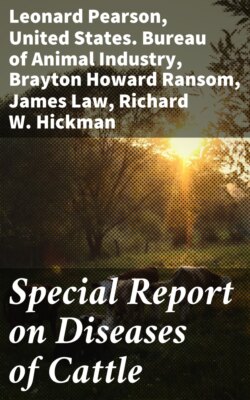Читать книгу Special Report on Diseases of Cattle - Lowe - Страница 58
На сайте Литреса книга снята с продажи.
THE ACTION OF POISONS.
ОглавлениеThe action of poisons may be either local, and exerted directly on the tissues with which they come in contact, or remote, acting through the circulation or the nervous system; or both local and remote action may be exerted by the same drug. Poisons which act locally generally either destroy by corrosion the tissues with which they come in contact or by inhalation set up acute inflammation. When any corrosive agent is taken into the stomach in poisonous quantities, a group of symptoms is developed which is common to all. The tissues with which the agent comes in contact are destroyed, sloughing and acute inflammation of the surrounding structures take place; intense pain in the abdomen and death ensue. In a like manner, but with less rapidity, the same result is reached if the agent used be not of a sufficiently corrosive nature to destroy the tissues, but sufficiently irritating to set up acute inflammation of the mucous membrane of the digestive tract. If the poison exerts a remote influence alone, the action is quite different, little or no local effect being produced upon the digestive organs.
To produce an effect on some part of the body distant from the channel of entrance, a poison must have been absorbed and carried in the blood to the central nervous system or other region involved. The poisonous effect of any substance is modified by the quantity used; by its chemical combinations; by the part of the animal structure with which it comes in contact; by the physical condition of the subject; and also by the rapidity with which the poison is excreted. As an illustration, opium may be given with safety in much larger doses to an animal suffering from acute pain than to one free from pain, and to an adult animal with greater safety than to a young one. The rapidity with which the poison is absorbed, owing to the part of the body with which it is brought in contact, is also an important factor. So marked is this quality that some agents which have the power of destroying life with almost absolute certainty when introduced beneath the skin, may be taken into the stomach without causing inconvenience, as curara, the arrow poisons, or the venomous secretion of snakes. Other agents in chemical combination may tend to intensify, lessen, or wholly neutralize the poisonous effect. For example, arsenic in itself has well-marked poisonous properties, but when brought in contact with dialyzed iron it forms an insoluble compound and becomes innocuous. Idiosyncrasies are not so noticeable in cattle practice as in practice among human beings, but the uncertainty with which some drugs exert their influence would lead us to believe that well-marked differences in susceptibility exist. Even in some cases a tolerance for poison is engendered, so that in a herd of animals equally exposed injurious or fatal effects do not appear with uniformity. For example, among cattle that are compelled to drink water holding in solution a salt of lead the effects of the poisoning will be found varying all the way from fatality to imperceptibility.
